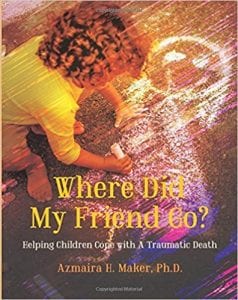Where Did My Friend Go? Helping Children Cope with a Traumatic Death
Available in large print paperback format
Author: Azmaira H. Maker, Ph.D.
Reviewed for the NABBW by: Anne L. Holmes
Today’s world is not as safe as the one we grew up in, in the 50s and 60s. Back then, we did not read about school shootings on a regular basis, for example. Yet even as we are only seven weeks into this year (2018) as I write — and we’re we collectively reeling from 17 deaths in Parkland, Florida — news reports tell us there have already been 8 school shootings that resulted in injury or death so far this year.
And of course, this year is not unique: An article by Polly Mosendz, published in Newsweek in late 2015 reports that between the beginning of 2013 and October 6, 2015, there were 142 school shootings. (The source for this information: an index created by Everytown for Gun Safety and Moms Demand Action for Gun Sense in America.)
Sadly, these acts of violence have become almost commonplace. But school shootings are not the only way young children today may be exposed to traumatic or violent death. Sadly, today there are so many other ways for a person to die traumatically that we won’t even begin to try to list them. Accidents, violent weather, murder, marauding zoo animals… You need only to turn on your TV news to learn the latest.
Which brings us to the point of this well-written and illustrated book: How to explain death to a young child.
I’ve only had to do this once, thankfully, and the children involved were older than the focal point of this book. Still I remember that the initial explaining process left me feeling totally inadequate.
But then there were the questions that come afterward. And the natural concerns:
- How to make them feel safe.
- How to ease their fears.
- How to make them feel better.
- Help them feel whole again.
- How to explain that death is part of the cycle of life.
- How to answer when they asked if I, too, was going to die…leaving them alone.
Of course, in the case of a traumatic death, it is our job to help involved children feel safe again. We need to know how to ease their fears that a traumatic death might also happen to them. How to help them work out their fears. Even to begin to be able to express them…
Questions about death are hard – even for an adult. These are questions theologians and philosophers debate. Trying to explain death in child-size words is guaranteed to make any parent, teacher, counselor or caregiver feel inadequate.
Thankfully, though, we now have this book to help us. It tells – in simple words and graphically enhanced photos – a simple story of a child losing a treasured friend. In writing it, clinical psychologist Azmaira H. Maker, Ph.D. provides a method for talking to children aged three to eight about traumatic death in a way that helps them feel safe again.
Dr. Maker offers discussion questions at the end of the book, which are used to encourage the child to write, draw or even act out their emotions and questions. The interventions also provide ways to help children explore their feelings and fears, learn to cope – and hopefully come to understand that can can once again feel safe.
Author Azmaira H. Maker, Ph.D., is a licensed clinical psychologist, speaker, and expert consultant on child development and parenting, who has been working with children and families for twenty years.
She holds a bachelor’s degree in psychology from Vassar College, and received her doctoral training at the University of Michigan, Ann Arbor, her post-doctoral fellowship training at the University of Michigan Hospital, Department of Psychiatry, and specialized training at the Child Advocacy Clinic at the University of Michigan Law School.
Dr. Maker specializes in child development, parenting, and psychotherapy and has extensive experience working in hospitals, schools, clinical agencies, and nonprofit organizations. She has also taught and supervised graduate and undergraduate students in play therapy, family therapy, and parent guidance, and has published several research and theoretical articles in scientific, peer-reviewed professional psychology journals.
With both Where Did My Friend Go? and her debut title, Family Changes, Dr. Maker offers young children a safe way to explore loss and grief. Both are written with an eye toward educating, enlightening, and empowering both children and their parents.
- WINNER: 2017 PINNACLE BOOK ACHIEVEMENT AWARD, NATIONAL ASSOCIATION OF BOOK ENTREPRENEURS.
- FINALIST: 2017 BOOK EXCELLENCE AWARD.
- FINALIST: 2017 BEST BOOK AWARDS: CHILDREN’S PICTURE BOOK SOFT COVER NON-FICTION.
NABBW Contributing Author



